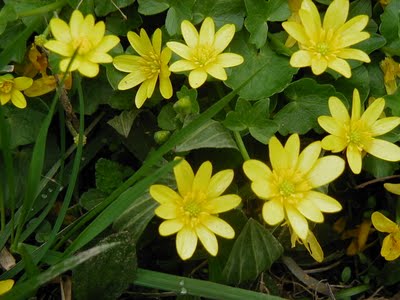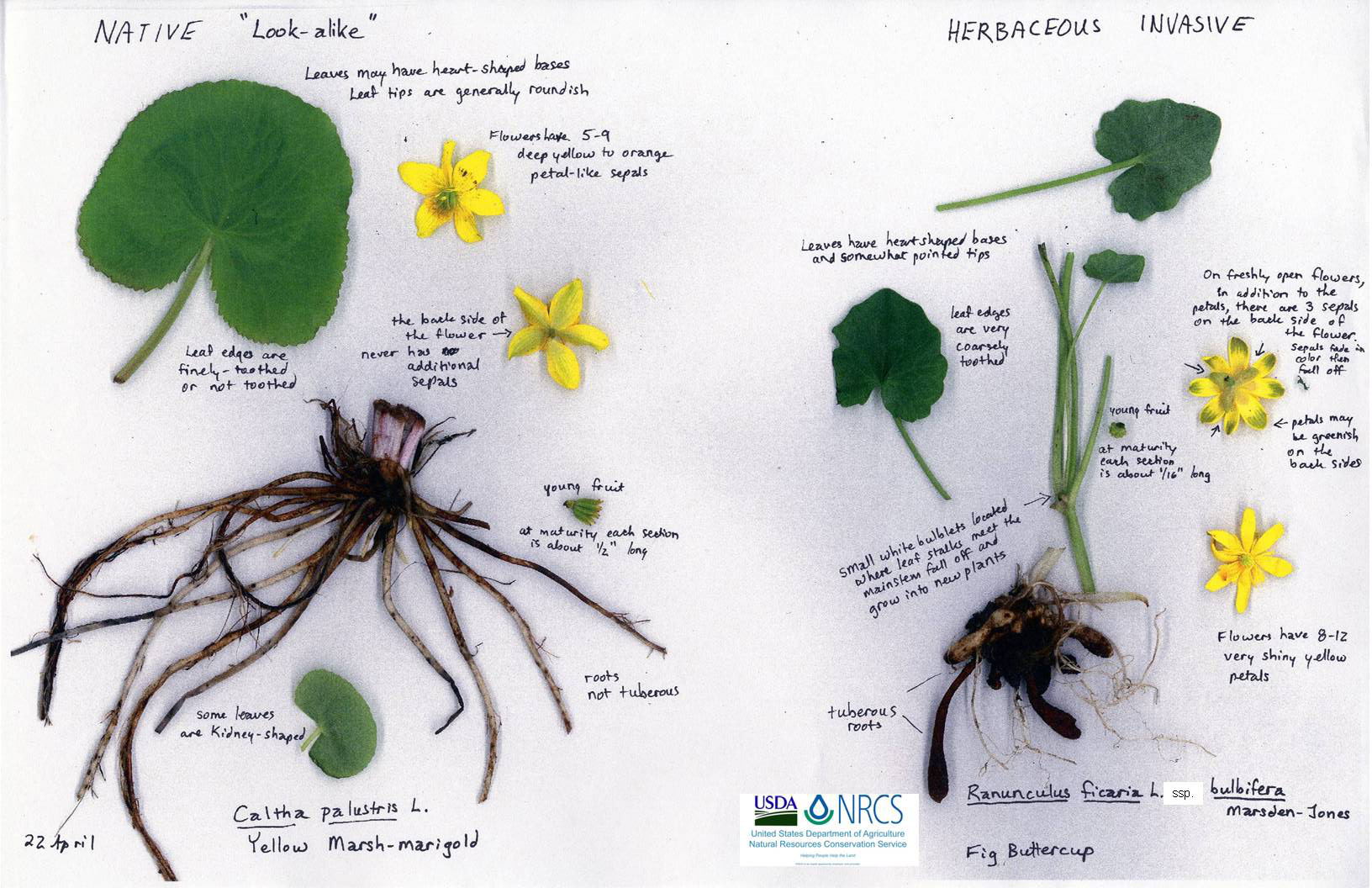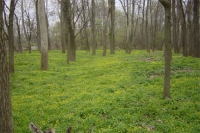 It's no wonder that lesser celandine was brought over to America as an ornamental planting; with its glossy, dark green leaves and its bright yellow, sunshine-y flowers, it really is beautiful. It can grow in any light condition from full sun to full shade, and while it prefers moist soils it can also grow up steep hills where water and nutrients are scarce. It is low-growing (no more than 11 inches tall) and spreads to form a thick mat of pretty yellow flowers. One other thing that makes it a great planting for a garden is that it is one of the first plants to emerge in the spring, making a house look cheery and bright while many other plants are still brown and dormant. Ironically, the traits that make lesser celandine a great garden plant are the very same characteristics that combine to make it an awful invasive to watch out for and eradicate when possible. Let's delve into this a little further.
It's no wonder that lesser celandine was brought over to America as an ornamental planting; with its glossy, dark green leaves and its bright yellow, sunshine-y flowers, it really is beautiful. It can grow in any light condition from full sun to full shade, and while it prefers moist soils it can also grow up steep hills where water and nutrients are scarce. It is low-growing (no more than 11 inches tall) and spreads to form a thick mat of pretty yellow flowers. One other thing that makes it a great planting for a garden is that it is one of the first plants to emerge in the spring, making a house look cheery and bright while many other plants are still brown and dormant. Ironically, the traits that make lesser celandine a great garden plant are the very same characteristics that combine to make it an awful invasive to watch out for and eradicate when possible. Let's delve into this a little further.
- Lesser celandine can grow in all kinds of light, moisture, and soil conditions, but so can many species of native plants that naturalists love. The ability to survive in lots of different micro-climates does not an invasive make.
- Lesser celandine divides and spreads to form a thick mat. This is often referred to as a monoculture, which means that there is only one species growing in a given area. Again, there are some native plants (sumac, for example) that will spread and spread and spread. While a plant's ability to spread quickly does make it an aggressive plant, being an aggressive does not necessarily label a plant as invasive.
- Lesser celandine emerges very early in the growing season, blooms early, and goes dormant by mid-June. Again, many prized native species emerge very early in the spring and are dormant again by early summer. Those plants are called spring ephemerals. Spring ephemerals usually grow on forest floors, where trees cast tons of shade. Our clever little ephemerals have figured out that they can maximize their sunlight if they start growing very early, right after spring thaw but before the trees above them have started to grow their leaves. They will grow, bloom, reproduce, and then go dormant again in a very short window of time before the leaves on the trees are full-grown. Again, early emergence does not an invasive make.
What does make lesser celandine an invasive plant (and a nasty one at that) is the combination of all three of the above characteristics, combined with some other factors which cause a plant to be out of balance within an ecosystem. Lesser celandine is so aggressive that many native plants that are very important for wildlife just can't compete. And lesser celandine emerges so early that it has already established itself by the time our native spring ephemerals are just starting to emerge. When our native spring ephemerals appear and start to fight for their space it's like a football match between first graders and high school seniors: one team has the clear advantage.
To top it off, lesser celandine has no (or few) natural enemies here in America, where it is so far outside of its native home range. On its home turf, there are myriad insects, animals, fungi, bacteria, parasites, and diseases that attack or feed on lesser celandine and keep its population in check. Much of our native wildlife (animals, birds, insects, bacteria, fungi, etc.) don't recognize lesser celandine as food. Animals (especially insects which are a very important part of the food web) tend to eat those plants that they have eaten for thousands of years, and lesser celandine simply hasn't been here long enough for wildlife (or pathogens) to adapt to eating (or infecting) it.
So, we've got an aggressive plant with no natural predators to keep its population in check. This plant emerges sooner than native spring ephemerals, and therefore has the advantage of size when competing for space and resources with native plants. It crowds out native plants, leaving them with no room or resources. The native plants (that support our wildlife populations) begin to die off because they have nowhere to grow. The native wildlife that only eat the native plants are now suddenly left with very little food on the table. Fewer native plants to eat translates into fewer native animals who can survive. The diversity and size of wildlife populations quickly declines. The situation starts to look pretty grim, doesn't it? And (in Cleveland, at least) it all started with a pretty garden plot in two homes.
What You Can Do To Help:
The story of lesser celandine is a good story to keep in mind when we choose plants for our gardens and yards. We never know what a plant (or animal for that matter) will do in a new area outside of its native range. We often don't realize the plant presents a problem until too late. One or two ten-dollar potted plants can turn into a multi-million dollar effort to eradicate an awful invasive plant. This story has been repeated over and over again throughout time. Lesser celandine is still widely available in nurseries all over the country, as are many other invasive plants. Check labels carefully when buying plants at the nursery to make sure that the plant is not labeled as aggressive or even invasive. Better yet, strive to plant natives in your yard. Have your yard be a refuge for native wildlife rather than "ground zero" for a future invasive infestation.

To take a look at some lesser celandine for yourself, take a walk south of the Urban Ecology Center's Riverside Park branch on the East Bank Trail. Look on the bluff side of the trail in between the Center and North Avenue. You will see a large patch of lesser celandine. Do not dig it up to transplant in your yard! This patch is on private property, and Urban Ecology Center land stewards are working to control its spread onto public natural land.
If you suspect that you have lesser celandine on your property, please consider taking action to eradicate it. Take special care not to confuse lesser celandine with marsh marigold (Caltha palustris) which is an important native plant that looks similar. The biggest difference is that lesser celandine spreads into a thick mat, while marsh marigold does not. For more information on lesser celandine, how to control or eradicate it, or on how to tell it apart from marsh marigold, please visit the National Park Service's website on lesser celandine.





